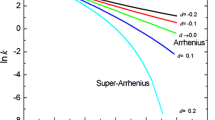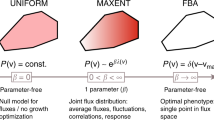Abstract
A phenomenological approach, based on the simple consideration of the cell duplication mechanism, is suggested to describe the microbial growth monitored through isothermal calorimetry. Correlation of the calorimetric trace with the cell microbial population can be assessed. The method permits to obtain directly the generation time trend τ(t) in all the phases of the growth process discriminating the influence of the peculiar experimental setup and focusing on the factors that are intrinsic to the microorganism. This type of elaboration offers a reference point in order to compare results from different laboratories for similar systems and for further kinetic and energetic exploitation of the microbial system. The paper reports the case of Lactobacillus helveticus as an experimental evidence.



Similar content being viewed by others
References
Braissant O, Wirz D, Göpfert B, Daniels AU. Use of isothermal microcalorimetry to monitor microbial activities. FEMS Microbiol Lett. 2010;303:1–8. doi:10.1111/j.1574-6968.2009.01819.x.
Itoh S, Takahashi K. Calorimetric studies of microbial growth: kinetic analysis of growth thermograms observed for bakery yeast at various temperatures. Agric Biol Chem. 1984;48:271–5. doi:10.1080/00021369.1984.10866155.
Beezer AE, Ashby LJ, De Morais SM, Bolton R, Shafiq M, Kjeldsen N. Drug bioassay, synergic interactions in drug combinations, thermodynamics and biologically based structure-activity relationships. A synthesis. Thermochim Acta. 1990;172:81–6.
Schiraldi A. Microbial growth and metabolism: modeling and calorimetric characterization. Pure Appl Chem. 1995;67:1873–8.
Fleming RMT, Thiele I, Provan G, Nasheuer HP. Integrated stoichiometric, thermodynamic and kinetic modelling of steady state metabolism. J Theor Biol. 2010;264:683–92.
Braissant O, Bonkata B, Wirzb B, Bachmann A. Microbial growth and isothermal microcalorimetry: growth models and their application to microcalorimetric data. Thermochim Acta. 2013;555:64–71.
Baranyi J, Roberts TA, McClure P. A non-autonomous differential equation to model bacterial growth. Food Microbiol. 1993;10:43–59.
Aragao GMF, Corradini MG, Normand MD, Peleg M. Evaluation of the Weibull and log normal distribution functions as survival models of Escherichia coli under isothermal and non-isothermal conditions. Int J Food Microbiol. 2007;119:243–57.
Vadasz P, Vadasz AS. Biological implications from an autonomous version of Baranyi and Roberts growth model. Int J Microbiol. 2007;114:357–65.
Baranyi J, Roberts TA. A dynamic approach to predicting bacterial-growth in food. Int J Food Microbiol. 1994;23:277–94.
Baranyi J, Pin C, Ross T. Validating and comparing predictive models. Int J Food Microbiol. 1999;48:159–66.
Buchanan RL, Whiting RC, Damert WC. When is simple good enough: a comparison of the Gompertz, Baranyi, and three-phase linear models for fitting bacterial growth curves. Food Microbiol. 1997;14:313–26.
Huang L. IPMP 2013: a comprehensive data analysis tool for predictive microbiology. Int J Food Microbiol. 2014;171:100–7.
Lopez S, Prieto M, Dijkstra J, Dhanoad MS, France J. Statistical evaluation of mathematical models for microbial growth. Int J Food Microbiol. 2004;96:289–300.
Swinnen IAM, Bernaerts K, Dens EJJ, Geeraerd AH, Van Impe JF. Predictive modelling of the microbial lag phase: a review. Int J Food Microbiol. 2004;94:137–59.
Schiraldi A, Fessas D. Classical and Knudsen thermogravimetry to check states and displacements of water in food systems. J Therm Anal Calorim. 2003;71:225–35.
Riva M, Fessas D, Franzetti L, Schiraldi A. Calorimetric characterization of different yeast strains in doughs. J Therm Anal. 1998;52:753–64.
Schaffer B, Keller B, Lorinczy D. Application of isotherm calorimetry in the development of foods containing probiotic live flora and enriched with bioavailable Ca2+. J Therm Anal Calorim. 2009;95:703–8.
Arioli S, Ragg E, Scaglioni L, Fessas D, Signorelli M, Karp M, Daffonchio D, De Noni I, Mulas M, Oggioni M, Guglielmetti S, Mora D. Alkalizing reactions streamline cellular metabolism in acidogenic microorganisms. PLoS ONE. 2010;5(11):e15520. doi:10.1371/journal.pone.0015520.
Gardikis K, Signorelli M, Ferrario C, Schiraldi A, Fortina MG, Hatziantoniou S, Demetzos C, Fessas D. Microbial biosensors to monitor the encapsulation effectiveness of Doxorubicin in chimeric advanced drug Delivery Nano Systems: a calorimetric approach. Int J Pharm. 2017;516:178–84. doi:10.1016/j.ijpharm.2016.11.033 (Epub 2016 Nov 11).
Slattery L, O’Callaghan J, Fitzgerald GF, Beresford T, Ross RP. Invited review: Lactobacillus helveticus a thermophilic dairy starter related to gut bacteria. J Dairy Sci. 2010;93:4435–54. doi:10.3168/jds.2010-3327.
Giraffa G. Lactobacillus helveticus: importance in food and health. Front Microbiol. 2014;5:338. doi:10.3389/fmicb.2014.00338.
De Man JC, Rogosa M, Sharpe ME. A medium for the cultivation of lactobacilli. J Appl Bacteriol. 1960;23:130–5. doi:10.1111/j.1365-2672.1960.tb00188.x.
Lamprecht I. Calorimetry and thermodynamics of living systems. Thermochim Acta. 2003;405:1–13.
Burkhard AH, Kuttler C, Müller J, Rothballer M, Hartmann A, Kreft JU. Does efficiency sensing unify diffusion and quorum sensing? Nat Rev Microbiol. 2007;5:231–9.
Acknowledgements
The authors are grateful to Prof. Maria Grazia Fortina, DeFENS University of Milan, for kindly supplying the L. helveticus cells.
Author information
Authors and Affiliations
Corresponding author
Rights and permissions
About this article
Cite this article
Fessas, D., Schiraldi, A. Isothermal calorimetry and microbial growth: beyond modeling. J Therm Anal Calorim 130, 567–572 (2017). https://doi.org/10.1007/s10973-017-6515-x
Received:
Accepted:
Published:
Issue Date:
DOI: https://doi.org/10.1007/s10973-017-6515-x




